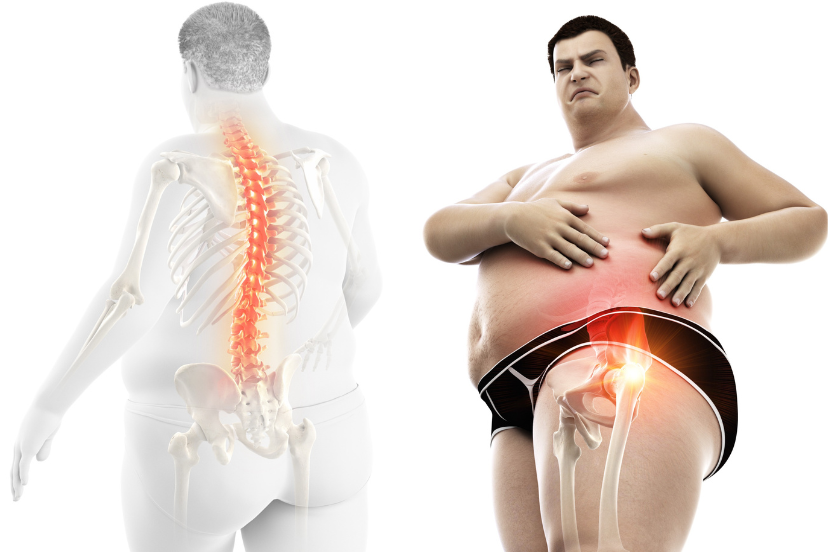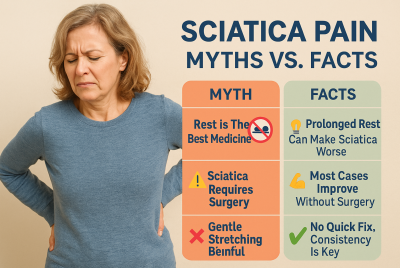Sciatic Nerve Pain In The Hip
Discover how to alleviate sciatic nerve pain in the hip. Learn about causes, symptoms, and effective treatments for relief. Before we start first, we need to understand what sciatic nerve pain is. There’s a reason why you’re here. And that reason is likely the distressing pain that you or someone you care about is experiencing – a pain that seems to originate from the lower back but swiftly goes down the leg. This could be sciatic nerve pain in the hip.
Sciatic nerve pain, or sciatica, is a discomforting condition centered around the hip area. Triggered by the irritation or compression of the sciatic nerve, it produces sharp, shooting pain radiating from the lower back through the hip and down the leg. Often caused by factors like herniated discs or muscle tightness, sciatic nerve pain can hinder mobility and daily activities. Effective diagnosis and a balanced approach to treatment, encompassing rest, therapy, pain management, and potentially surgery, are essential for relief and improved hip function.
An Overview Of The Sciatic Nerve
What Is The Sciatic Nerve?
The sciatic nerve, the largest in your body, starts from the lower spine, runs through the buttock, and branches down the back of each leg. Imagine it as the main highway that connects your brain with your lower body.
The Role Of The Sciatic Nerve
It’s the one responsible for feeling and muscle control in your legs. Like an essential power line, it conducts electrical signals back and forth between your brain and your lower body. Pretty crucial, right?
Unraveling Sciatica Causes And Symptoms
Can Sciatica Cause Hip Pain On Both Sides?
While sciatica typically affects one side of the body due to the irritation or compression of the sciatic nerve on that side, it’s possible for certain underlying conditions to cause hip pain on both sides. Bilateral sciatic pain could arise from factors like spinal stenosis, where the narrowing of the spinal canal affects both nerve roots. Additionally, conditions affecting the pelvis or sacroiliac joints might lead to symmetrical hip discomfort. If you’re experiencing hip pain on both sides, it’s essential to consult a healthcare professional for an accurate diagnosis and tailored treatment to address the underlying cause.
Causes Of Sciatica
Now let’s delve into what causes this discomfort. The main culprits are:
Lumbar Herniated Disc
Picture your spinal discs as jelly doughnuts. When the jelly pushes out, it can irritate the nerve root. Ouch! Imagine your spinal discs as jelly-filled doughnuts. Sometimes, the jelly-like center can protrude out, irritating the nearby nerve root—a condition known as a lumbar herniated disc. This compression can lead to sharp pain, tingling, and weakness, causing discomfort like hitting your funny bone. Proper diagnosis and treatment, such as rest, physical therapy, or even surgery in severe cases, aim to relieve the nerve pressure and alleviate the ‘ouch’ of this condition.
Spinal Stenosis
Have you ever been in a tight spot? Well, this is the spinal version, where the spaces within your spine narrow down, pressing on the nerves. Imagine a tight squeeze, but in your spine—this is spinal stenosis. The spaces within your spinal column narrow, and the resulting pressure on nerves can cause pain, numbness, and weakness. It’s like feeling cramped in a tight space. Treatment options, including physical therapy, medications, and surgery in severe cases, aim to alleviate the discomfort and create more room for your nerves to breathe in the spinal corridor.
Spondylolisthesis
A tricky word for a condition where a vertebra slips over the one below it. Yeah, it’s as uncomfortable as it sounds. Spondylolisthesis is a tongue-twister describing a condition where a vertebra slips over the one below it. Just like it sounds, it’s quite uncomfortable. This displacement can cause pain, nerve compression, and reduced spinal stability. Picture a misaligned stack of blocks. Treatment involves rest, physical therapy, bracing, or surgery in severe cases, aiming to realign the vertebrae and restore comfort in your spine’s building blocks.
Symptoms Of Sciatic Nerve Pain
Sciatica symptoms typically include hip pain, buttock pain, and discomfort along the sciatic nerve path. It’s like a pesky visitor that overstays their welcome. Sciatica symptoms often encompass hip and buttock pain, extending along the sciatic nerve path. It’s akin to an unwelcome guest that lingers too long. The pain can be sharp, shooting, and may radiate down the leg, accompanied by tingling, numbness, or weakness. As you’d show an overstaying visitor the door, seeking medical attention can help evict the discomfort and restore your comfort.
What Are 2 Symptoms Of Sciatica?
Two common sciatica symptoms are sharp, shooting pain that radiates from the lower back through the buttocks and down the leg, often affecting only one side. This pain can be intense and is often described as electric, burning, or searing. Additionally, individuals with sciatica might experience numbness, tingling, or weakness in the affected leg, further impacting mobility and comfort. These symptoms can range in severity, with activities like sitting, standing, or walking exacerbating the pain. Proper diagnosis and tailored treatment are essential to alleviate these symptoms and address the underlying cause of sciatica.
Dealing With Sciatic Nerve Pain In The Hip
How Long Does Hip Sciatica Last?
The duration of hip sciatica can vary widely depending on its underlying cause, severity, and effectiveness of treatment. Acute sciatica, caused by a sudden injury or inflammation, may last a few weeks to a few months. Subacute sciatica might persist for several months, while chronic sciatica, stemming from conditions like herniated discs or spinal stenosis, can last for months to even years if not properly managed. Early intervention with conservative treatments such as rest, physical therapy, and pain medication can expedite recovery. More advanced interventions like injections or surgery might be considered if the condition remains persistent. Consulting a healthcare professional for a personalized assessment and treatment plan is essential.
What Does Sciatic Nerve Pain In Hip Feel Like?
Sciatic nerve pain in the hip manifests as a searing and throbbing discomfort. It typically originates in the lower back or buttocks and shoots down the back of the leg, often affecting only one side. This pain is characterized by its intensity, sometimes likened to an electric shock or burning sensation. Alongside the physical discomfort, individuals might experience tingling, numbness, or weakness in the leg. Activities like sitting, standing, or walking can exacerbate the pain, making daily routines challenging. Recognizing these symptoms is crucial for proper diagnosis and timely treatment to alleviate the discomfort and restore normal mobility.
Non-Surgical Methods For Relief
Luckily, there are ways to bid adieu to this pain:
Physical Therapy
It’s like a workout plan for your nerve. Special exercises and stretches can help alleviate the pain. Consider it as your very own pain-fighting regimen.
Physical therapy for sciatic pain involves targeted exercises to strengthen muscles supporting the spine, improve flexibility, and correct posture, reducing pressure on the sciatic nerve. It also includes pain management techniques like heat/ice therapy or electrical stimulation. Regular sessions can alleviate acute symptoms and prevent future occurrences by promoting healthier movement habits and spinal health.
Over-The-Counter Medications
Pain relievers and anti-inflammatory drugs can be short-term friends in your pain relief journey.
Over-the-counter medications like nonsteroidal anti-inflammatory drugs (NSAIDs) relieve sciatic pain by reducing inflammation around the sciatic nerve, thereby alleviating pressure and pain. Acetaminophen works centrally in the brain to reduce pain perception. Topical creams with ingredients like capsaicin or menthol can also soothe the affected area, temporarily relieving discomfort.
Lifestyle Modifications
This includes healthier habits like maintaining good posture, regular exercise, and a balanced diet. It’s like giving your body the right armor to fight this battle.
Exercise can be incredibly beneficial in managing sciatic nerve pain in the hip.
Here are some exercises that might help:
- Knee to Chest Stretch: Start by lying on your back with your legs stretched out. Slowly bend one knee and bring it towards your chest. Hold it there for about 20-30 seconds. Repeat this exercise with the other leg.
- Piriformis Stretch: While lying on your back, bend your knees and place the right ankle on the left knee. Hold the position for a few moments and then switch legs.
- Lower Back Stretch: While on all fours, slowly sit back on your heels and stretch your arms forward along the ground. Hold this position for about 20 seconds.
- Spinal Twist: Sit on the floor with your legs extended in front of you. Bend your right knee and cross it over your left leg, placing your right foot flat on the floor. Twist your torso to the right and place your left elbow against your right knee. Hold this position for about 30 seconds and then repeat on the other side.
- Hamstring Stretch: Stand up straight and put one foot in front of you, the heel on the ground, toes pointing upwards. Keep your back straight, lean forward from your hips, and feel the stretch in the hamstring of your front leg.
These exercises often help, but they are not suitable for everyone. It’s essential to consult with a physical therapist or healthcare provider before starting a new exercise regimen.
Surgical Interventions For Sciatica
If the non-surgical methods don’t provide relief, surgery may be an option:
Microdiscectomy
Imagine a small unwanted part of your herniated disc being taken out, giving your sciatic nerve the breathing space it needs.
Microdiscectomy is a minimally invasive surgery to remove the portion of a herniated disc pressing on the sciatic nerve. By relieving this pressure, it alleviates associated pain. The procedure involves a small incision, minimal tissue disruption, and usually has a faster recovery time than traditional surgery, effectively restoring mobility and improving quality of life.
Lumbar Laminectomy
A bit like a room enlargement, this procedure widens the space for your nerves in the lower spine to relieve pressure.
Lumbar laminectomy is a surgery that removes the back part (lamina) of a vertebra to create space, relieving pressure on the spinal cord or nerves, like the sciatic nerve, which can reduce sciatica pain. This procedure is typically used when conservative treatments fail, for severe, debilitating pain, or in the presence of significant neurological symptoms.
Sciatica Pain So Bad Can’t Walk
Severe sciatica pain can incapacitate mobility to the point where walking becomes difficult or even impossible. The intense shooting pain, often accompanied by numbness and weakness, can render the affected leg unstable. In such cases, attempting to walk might worsen the pain and potentially lead to compensatory movements that affect the overall posture. Immediate medical attention is crucial if sciatica pain reaches this level of severity. Healthcare professionals can assess the situation, provide appropriate pain management strategies, and recommend physical therapy, medications, or surgical interventions to alleviate the pain and restore mobility over time.
Is Walking Good For Sciatica Hip Pain?
Walking can benefit sciatica hip pain, but it should be approached with caution. Gentle walking can help improve blood flow, release endorphins for pain relief, and maintain mobility. However, individuals should avoid excessive walking or activities that worsen the pain. Listen to your body – if walking exacerbates discomfort, take breaks, and consider shorter, slower walks. Consulting a healthcare professional is crucial to determine the appropriate activity level and create a balanced approach to managing sciatica. They can guide exercises, stretches, and pain management techniques that suit your condition and promote healing.
When To Seek Medical Help
Seek medical assistance if symptoms persist or worsen over a few weeks or are accompanied by severe pain, numbness, or weakness in the leg. Additionally, immediate medical attention is crucial if you experience bowel or bladder dysfunction, unexplained weight loss, or trauma. Consult a healthcare professional if pain disrupts daily activities, interferes with sleep, or if over-the-counter pain relief methods provide inadequate relief. Early intervention can prevent complications and ensure an accurate diagnosis, leading to a tailored treatment plan that effectively manages the underlying cause of sciatic nerve pain.
Frequently Asked Questions (FAQs)
1. How long does sciatic nerve pain last?
The duration of sciatic pain varies from person to person. For some, it might last a few weeks, while others may experience it for several months.
2. Can sciatica cause permanent damage?
While sciatica can be painful and bothersome, it rarely leads to permanent nerve damage. However, if you experience severe, sudden pain or loss of sensation, seek immediate medical help.
3. How can I ease sciatic nerve pain at home?
Over-the-counter medications, hot and cold packs, and gentle exercises can help manage pain. But remember, these are only temporary measures.
4. Does walking help sciatica?
Absolutely! Walking can improve lower back flexibility and posture and strengthen the muscles that support your back and leg, which can help relieve sciatic pain.
5. Should I rest or keep active when dealing with sciatica?
Staying active can help reduce inflammation, but listening to your body is also essential. If an activity causes pain, taking a break and rest is better. Balancing rest and activity is key for sciatica. While short-term rest helps reduce inflammation and acute pain, prolonged inactivity can worsen symptoms. Gentle activities like walking or prescribed exercises can maintain mobility, strengthen the back, and promote healing. Consult a healthcare professional for personalized advice, as individual responses to rest and activity can vary.
Sciatic Nerve Pain In The Hip – Conclusion
In conclusion, I hope this deep dive into sciatic nerve pain in the hip has been enlightening. Remember, sciatica is a common condition, but it’s not invincible. We have methods to combat it. Whether it’s physical therapy, lifestyle changes, or in extreme cases, surgery, there is always a way out of the pain, and it can be a treatment for your pain. So take heart, and keep exploring your options!
Disclaimer
Please note that this article should not replace professional medical advice. Consult a healthcare professional for an accurate diagnosis and tailored treatment plan.
👉 Explore more:





